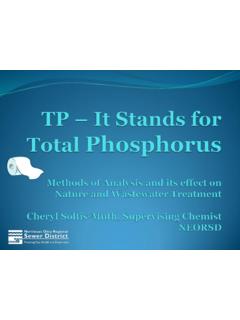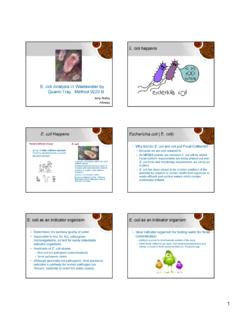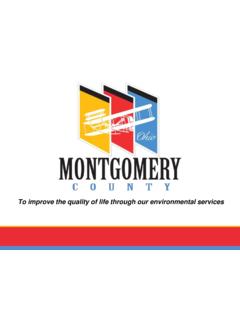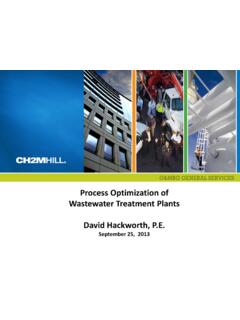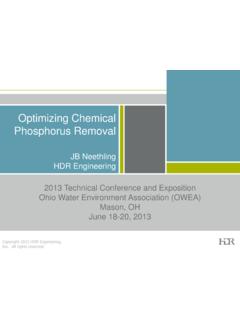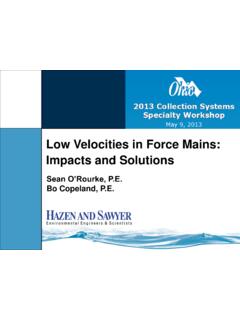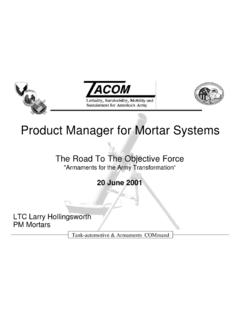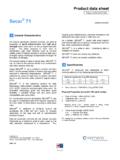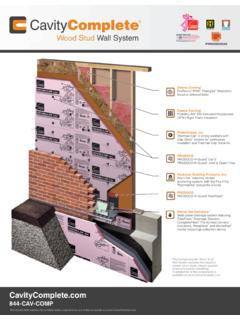Transcription of BASIC MECHANISMS OF CORROSION AND …
1 BASIC MECHANISMS OF CORROSION AND CORROSION CONTROL FOR WATER AND WASTEWATER SYSTEMS Graham Bell, , Department manager and Sr. VP Walking Through the Minefield of CORROSION Internal CORROSION Market Driver for CORROSION Control is Entropy Our Business is Guaranteed by a Fundamental Law of Nature: DSuniverse 0 DEFINITION OF CORROSION CORROSION is the deterioration of a substance or its properties as a result of an undesirable reaction with the environment. It is irreversible and degenerative and related to the Second Law Thermodynamics - NACE International Energy spontaneously tends to flow only from being concentrated in one place to becoming diffused or dispersed and spread out.
2 Everything You Need to Know About CORROSION 4 Parts of a CORROSION Cell Anode (location where CORROSION takes place) oOxidation Half-Reaction Cathode (no CORROSION ) oReduction Half-Reaction Electrolyte (Soil, Water, Moisture, etc.) Electrical Connection between anode and cathode (wire, metal wall, etc.) Electrochemical CORROSION can be stopped by eliminating any one of the 4 components Electrochemical CORROSION Cell A C e- Metallic Path + ions - ions Electrolytic Path Anode Cathode Electrolyte Metallic Path Electron Flow Can you find the anode? Anode Electrolyte Metallic Path Cathode CORROSION The CORROSION Puzzle Anode Electrolyte Metallic Path Cathode CORROSION Remove any piece of the puzzle and CORROSION stops!
3 Cost of CORROSION is about of GDP (50% to 70% Related to Civil Engineering) 2010 US GDP = $ Trillion Cost of CORROSION = $460 Billion $ $ $ $ $-$-$ $ $ $-$ $ $ $ $ $ $ $ $ $ $ $ $-$ $ $ $-$10$20$30$ Of CORROSION Per Analyzed Economic Sector, ($ x billion)Highway BridgesGas and Liquid Transm. PipelinesWaterways and PortsHazardous Materials StorageAirportsRailroadsGas DistributionDrinking Water and Sewer SystemsElectrical UtilitiesTelecommunicationMotor VehiclesShipsAircraftRailroad CarsHazardous Materials TransportOil and Gas ProductionMiningPetroleum RefiningChem., Petrochem., and PaperAgriculturalFood ProcessingElectronicsHome AppliancesDefenseNuclear Waste Storage $63 B (2010) (1998) Annual 1998$ $14B (2010) $41B (2010) $35B (2010) Objectives of the Most Infrastructure Projects Provide a 50 + Year Useful Life Useful life means: Functionality Assured Structural Integrity Maintained Operating Costs Controlled How do we do this?
4 Control the two time dependent degradation MECHANISMS CORROSION Fatigue Creep (Generally Not Applicable) Two distinct and different types of Situations: New Pipe (Lot of Options) Chance to Do it Right Right of Way Study through Construction Existing Pipe (Limited Options) Sins of the father Condition Assessment For both, CORROSION Control is a Process, not a Project. Material Selection/Design Details Choose materials compatible with environment. Do not create CORROSION cell through design/construction details. CORROSION Inhibitors Alter the environment adjacent to metal to passivate and protect metal.
5 Concrete or mortar on steel are inhibitors Concepts of the Four BASIC Methods CORROSION Control Cathodic Protection Electrochemically alter the surface condition of the metal to move the anodic reactions elsewhere. Coatings (exterior) and Linings (interior) Provide a barrier to the electrolyte and protect the metal. Usually dielectric material that prevents electron and ionic current flow. Concepts of the Four BASIC Methods CORROSION Control (continued) Coatings and Cathodic Protection Work Together Cathodic protection can be applied with out coatings. Coatings should not be used with out cathodic protection.
6 Cathodic protection effectively protects defects in the coating. In many environments actually repairs the coating locally by depositing minerals that plug the holes in the coating Effect of Cathodic Protection Current ANODE volt CATHODE volt Icorr= 1 mA ANODE volt CATHODE volt Icorr= .3 mA Before Cathodic Protection After Cathodic Protection Reduction in CORROSION current CURRENT Cathodic Protection Stops Leaks $$ are Directly Proportional to Current Capacity (Amps) Life Cycle Costs = Construction + Operating Costs Initial/Construction costs ~ Amps Operating/Maintenance Costs ~ Amps Anything and everything you do to reduce current requirement saves $$$.
7 Pipe Material Coating system Current Requirement (ma/sf) Steel/Iron None 1 to 3 Steel AWWA C205 to Steel/Iron Dielectric Coating AWWA C214, 217, 222 to Ductile Iron with PE AWWA C105 to CP Current Requirements for Water Industry Piping Water vs. Wastewater: External CORROSION MECHANISMS are identical CORROSION Control for Exterior is Identical Materials, Design and Construction Practices But Wastewater construction does not typically account for the eventual need for cathodic protection oElectrical Continuity of Pipelines and Structures oElectrical Isolation for Appurtenances Water vs.
8 Wastewater: Internal CORROSION Not the Same At All. CORROSION Rates for wastewater can be extremely high. More often internal CORROSION leads to problems This is one reason why external CORROSION is ignored. H2S+2O2H2SO4SO42-+organic matterS2-+2H+H2 SAnaerobicBacteriaS2-+H2O+CO2 Sludge and siltH2SH2SH2SH2 SSulfur Reducing BacteriaSulfur oxidizing bacteriaH2S+2O2H2SO4SO42-+organic matterS2-+2H+H2 SAnaerobicBacteriaS2-+H2O+CO2 Sludge and siltH2SH2SH2SH2 SSulfur Reducing BacteriaSulfur oxidizing bacteriaInternal CORROSION of Wastewater Systems Dominated by Formation of Sulfuric Acid Indirect Impact of Regulations on CORROSION H2S crown2-10 ppmpH 3-4H2S crown~ 30ppmpH 1-2 Clean Water Act of 1980 Clean Water Act of 1980 Reduced metal concentrations in sewageElevated levels of bacterial growthElevated
9 Levels of bacterial growthH2S crown2-10 ppmpH 3-4H2S crown~ 30ppmpH 1-2 Clean Water Act of 1980 Clean Water Act of 1980 Reduced metal concentrations in sewageElevated levels of bacterial growthElevated levels of bacterial growthH2S crown2-10 ppmpH 3-4H2S crown~ 30ppmpH 1-2 Clean Water Act of 1980 Clean Water Act of 1980 Reduced metal concentrations in sewageElevated levels of bacterial growthElevated levels of bacterial growthWater Line CORROSION Blistering Submerged Unsubmerged Springline Crown Internal CORROSION DIP for Force Main Gas Pocket CORROSION Internal CORROSION CORROSION Control for the Outside of CMC or Concrete Water Pipes AWWA C205, C300, C301, or C303 Corrosivity of alignment must be determined Saturated ASTM G57 Soil Resistivity > 1500 -cm oChlorides < 350 ppm in soil oSulfates < 2,000 ppm in soil oNo fluctuating groundwater in pipe zone.
10 PH > References AWWA Manual M27 External CORROSION AWWA Manual M28 Rehabilitation of Water Mains AWWARF Report 90987 External CORROSION and CORROSION Control of Buried Water Mains NACE International Standards SP0169; SP0207; Peabody Control of Pipeline CORROSION Things we try to Financial Motivation Shrinking Budgets GASB 34 Political Motivation Career Limiting Events Regulatory Motivation Jail Oil and Gas Model Condition Assessment is Part of the Asset Preservation Budget Accessibility/Availability of Asset Risk Tolerance Best Practice is to use multiple methods Selection of Condition Assessment Technology Depends on Several Factors Historical Information Design Information Leak and Break Rates Geographical Information Where should I look?




